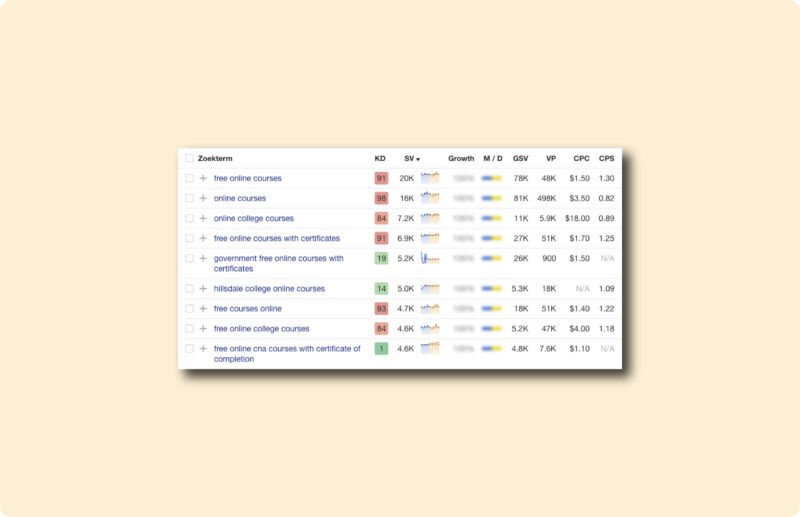Entity-based SEO: how to build and leverage entities

Search engines such as Google understand the Web less and less as a collection of individual words, and more and more as a network of entities: Entity-based SEO. This requires a different approach to SEO: fewer keywords, more context.
To build visibility in a semantic web, I think about entities (what they are, how you structure them and how you position them within your niche).
What are entities in SEO?
An entity, in the context of search engines, is a unique and clearly identifiable concept, person, organization, location or thing. Think “Ralf van Veen,” “SEO optimization” or “Google Search Console.
These are terms that Google tries to understand regardless of how they appear on a page.
Instead of looking at keyword density or exact search terms, Google is increasingly looking at how well a topic is understood, connected and explained. Pages strongly anchored around clear entities are more reliably interpreted by the algorithm. (1)
Why entities are essential for modern SEO
The introduction of systems such as the Knowledge Graph and BERT has made Google much smarter contextually.
As a result, Google not only judges what you say, but also who or what you write about, and topical authority becomes more important than purely backlinks or keywords. Also, you can still realize more ranking potential with less content if you are well connected to relevant entities
Google uses entities to make connections between topics on the Web. If you appear between them with clear signals, it strengthens your findability on multiple search terms at once.
How do you build entities?
A strong entity does not come about by itself. You build it properly from three pillars:
1. Structure your content
Make sure you cover several sub-topics around one main topic, each with a clear focus. You don’t want to fragment, but delve deeper. Internal links, silos and content clusters play a key role here.
2. Consistent signals in your online presence
Your entity should look the same in multiple places on the Web. Consider structured data (schema.org) on your site. Also pay attention to unambiguous company listings (Google Company Profile, social profiles or press mentions). To do so, also use brand names and domains in external sources correctly.
3. Build authority through contextual content
Not every link counts equally when it comes to authority. Links from content that is strongly related to your entity in terms of content are more valuable. Publish on platforms that already have authority within your topic and choose content relevance over quantity.
Getting started with SEO? Feel free to get in touch.

How do you leverage existing entities?
Google already knows many entities (via Wikidata, Wikipedia or its own Knowledge Graph). By cleverly linking existing entities to your content, you increase your findability.
For example, deploy tools like Google’s NLP API to find out which entities are recognized in your text. In addition, consult sources such as Wikidata or Google Knowledge Panels to see which terms have been defined as entities by Google. Also analyze search results (think PAA blocks and related searches) to identify semantic links.
Then integrate these entities into your content naturally. Not as keyword-stuffing, but as contextual reinforcement. In doing so, use terms such as people, places or terms in a way that helps Google interpret them correctly.
Linking entities to search intentions
In addition to naming entities, it is essential that they are logically linked to the user’s search intent. A page about solar panels that I worked on also talks about ‘feed-in fee’, ‘net-metering scheme’ and ‘inverters’ gives Google clarity on semantic scope. That increases the chances of better rankings as well as featured snippets.
The role of structured data
Structured data helps search engines more quickly understand what your content is about and what entity you represent. Always include schema whenever possible, such as:
- Organization and Person schedules on your about-us page
- Article or FAQPage markup on blog content
- Product schema at commercial propositions
With structured data, you increase the chances of rich snippets as well as make your content more understandable to search engines. (2)
Think in relationships, not single pages
Entity-based SEO requires a network approach. Pages should be logically connected, overlap in content, reinforce each other. It is not a collection of isolated articles, but an information structure that explains a topic in depth.
Those who build content in this way automatically increase the semantic relevance of the domain. In doing so, you not only boost rankings on main keywords, but also on hundreds of semantically related terms that you wouldn’t otherwise rank for.
Summary
Entity-based SEO is all about understanding and being understood. You no longer build authority just through keywords or backlinks, but by claiming your place within the larger information network that Google is trying to structure. By actively building entities and using them intelligently, you lay the foundation for an SEO strategy that aligns with how search engines understand information today and tomorrow.
Anyone who wants to stay findable today must do more than process keywords. Build a network, be visible in meaningful places, and show Google where you belong.
| # | Source | Publication | Retrieved | Source last verified | Source URL |
|---|---|---|---|---|---|
| 1 | What is Entity-Based SEO? (z.d.) (Ahrefs) | 22/05/2025 | 22/05/2025 | 12/10/2025 | https://ahrefs.com/seo/g.. |
| 2 | Structured data and SEO: What you need to know in 2025 (Search Engine Land) | 07/10/2024 | 07/10/2024 | 26/10/2025 | https://searchengineland.. |
- (22/05/2025). What is Entity-Based SEO? (z.d.). Ahrefs. Retrieved 22/05/2025, from https://ahrefs.com/seo/glossary/entity-based-seo
- Olya Ianovskaia. (07/10/2024). Structured data and SEO: What you need to know in 2025. Search Engine Land. Retrieved 07/10/2024, from https://searchengineland.com/structured-data-seo-what-you-need-to-know-447304






